Assignment 1: Heritage By The Numbers
PART I:
The first step of the assignment is to compare parsing through the Harvard Art Museum’s collections and objects through their website to their CSV file from the Posit Cloud Jupyter Notebooks. This part of the assignment was started in class, and from the get-go it was clear that reading through a CSV file is not a simple feat. It is simply not very human friendly because all the information runs together as one large body. However, through the Harvard Art Museum’s web interface, objects from the collections are more often accompanied by photographs of the artefact as well as the information needed to understand its history and significance.
I was very intrigued by the idea of Special Collections on the HAM website, therefore, my collection focus was on that. Allan Burrough’s Collection of X-radiographs specifically interested me because the radiographs resembled art pieces of printmaking. I am currently enrolled in a printmaking class and it took me a while to realise radiographs were a form of photography and not printing. However, as soon as I started to dig deeper into this collection, I realised a lot of the pieces were not photographed, therefore there was no visual reference to them in the collection. I lost interest in the pieces that had no visual reference and only focused on the ones I can actually see. It made me question things like accessibility and how our eyes affect the way we interact with screens, and even physical spaces such as museums. On the HAM website, I was also able to see certain information about the pieces, such as who the original artist of the art that was radiographed is, its title, and object number.
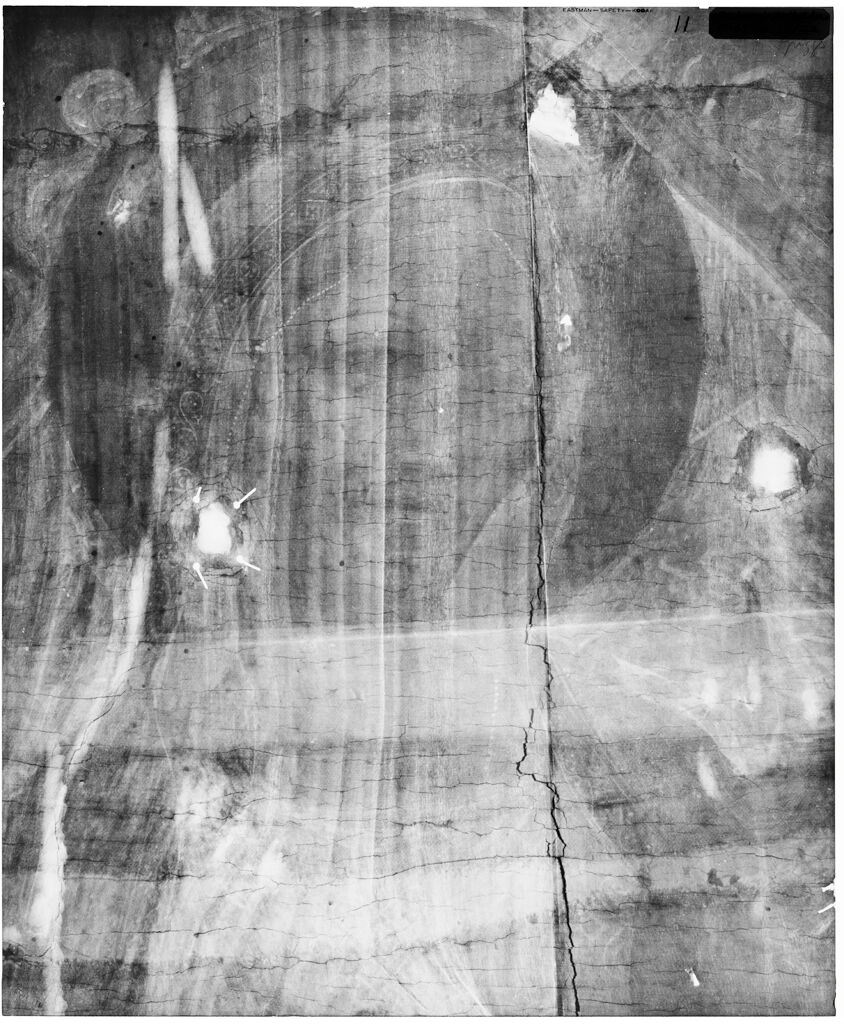
On the other hand, when I was trying to make sense of the CSV file to find an object, I found myself randomly selecting one instead of taking the time to read them. Although I do understand the structure of CSV files, and on the very top of the file it lays out exactly how each entry will be documented: “ID,title,description,century,…” it was not hard to extract information about certain pieces. With that said, the CSV file was just too overwhelming to parse through normally as a human being, and especially for me as a visual learner. So I resorted to simple scrolling endlessly and picking out a line with my eyes closed to investigate further. I picked out the piece on line 594 from the CSV file, and from the information provided, I was able to extract the ID, title, and a few other details, and was more than pleased with my selection. The piece that I stumbled upon is titled “What a Glorious Land!” a Chinese painting dated to the 21st century and filed under Asian and Mediterranean Art. The piece was acquired by the HAM in 2006 and I was lucky enough to get a description that read: “This handscroll depicts a range of tree-covered mountains shrouded in mist. A title written by the artist precedes the painting; the title is a line from a 1936 poem by Mao Zedong and reads “Jiangshan ruci dou jiao”. It can be translated as “What a Glorious Land!”, though it is also translated as “This land, so rich in beauty.” Although this short description, and the details that came through the CSV file were very informative, I was more intrigued to copy the link into google just to see the images. Let’s just say, I was more than pleased with it.
What I appreciated about parsing through the CSV file, is the ease by which I can access all the objects and pieces in one place instead of clicking into collections and changing pages to find certain pieces. I also enjoyed how the randomness of scrolling through the file to randomly stop on a line and choose to investigate it has an air of excitement and intrigue that cannot be achieved by looking through a website. Although it is very tiring on the eye, the CSV file is the simplest form of including all the basic information of ALL the pieces in the museum in one single place. On the other hand, even with researching the Chinese scroll from the CSV file, I copied the URL and pasted it into google to be directed to the HAM website where I realised just how much more information is available on the piece, not just visually, but also details on the artist, physical descriptions of the piece, and creation place all of which were not included in the CSV file.

PART II:
For the second part of this exercise, I made sure to choose a culture that had a relatively small number of objects on the HAM website whilst still being somewhat relevant to my Arab background. That way I will be able to analyse all the objects against one another to determine why one is more or less relevant in terms of pageviews and to have an understanding of the art’s meaning in some form as well thereby deepening my analysis.
I chose the Moroccan culture off of the CSV file titled All_Culture_information.csv which had a total of 28 object entries. Twenty-eight objects gives me a large enough pool of information to compare while still staying somewhat small enough to look at every object closely.
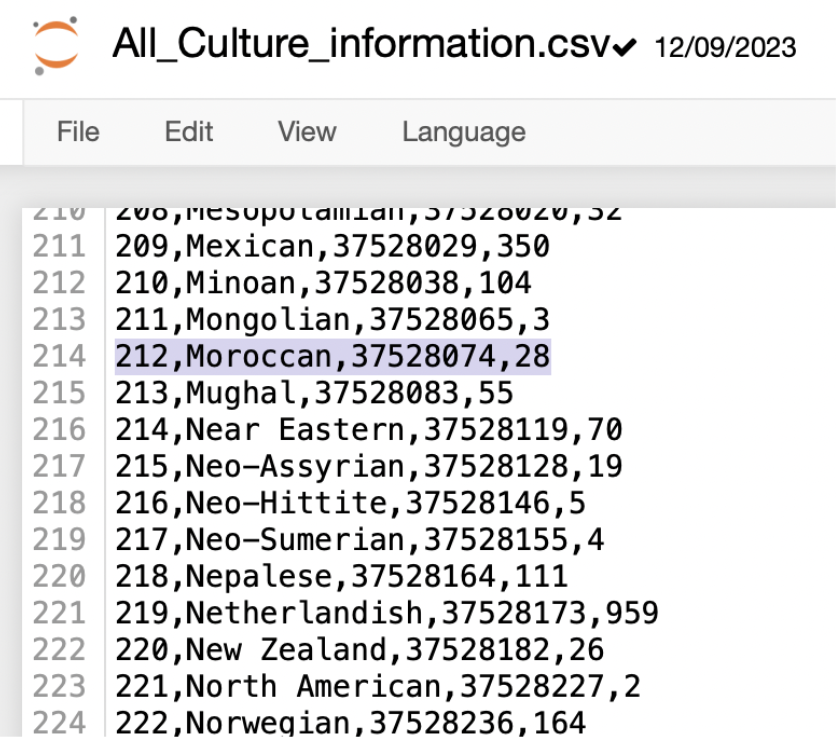
Since Moroccan culture has existed for over a thousand years, I avoided specifying a century in the initial run of the program as I wanted to see what time period the objects collected by the Harvard Art Museum came from or whether they were periodically spread out. I started with the descending classification of Moroccan culture to get a sense of what people were intrigued by or searched for more.
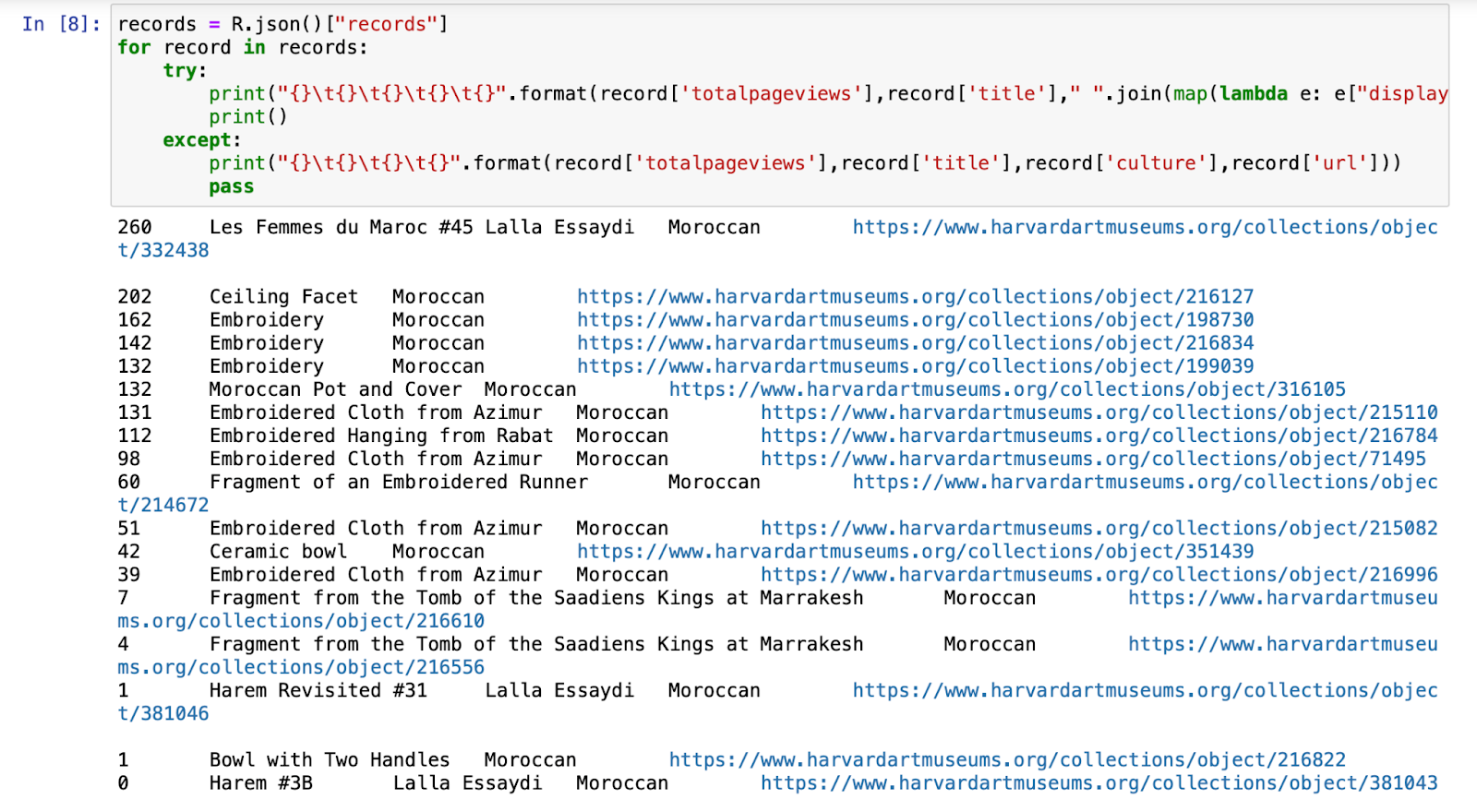
These were my top results for the descending classification. The first 17 pieces were viewed by others whilst the remaining 11 were not viewed by anyone. Observing the initial spread of information, I can see that Moroccan work is not that popular with viewers of the website as the most viewed item has a mere 200 viewers. Now this can be for a number of reasons including potentially the piece being only exhibited for a short period of time in the museum physically. Another intriguing observation about the spread on Posit Cloud was that the least viewed items came from the same artist as the most viewed item.
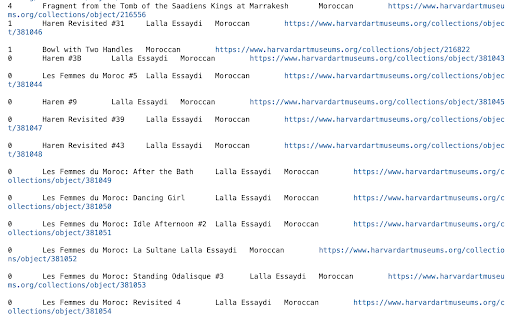
Upon further inspection, the reason for the same artist’s work also showing up as part of the least viewed items in Moroccan culture is the lack of photographs on the object’s information page. But I also realised that it related back to the object’s accession year as well. Essaydi’s Revisited piece was acquired by the Harvard Art Museum just this year, 2023, as a gift from Donald and Alison Weiss making it a relatively newer addition to the website hence explaining the lack of image documentation of the piece as well as the low page view count.
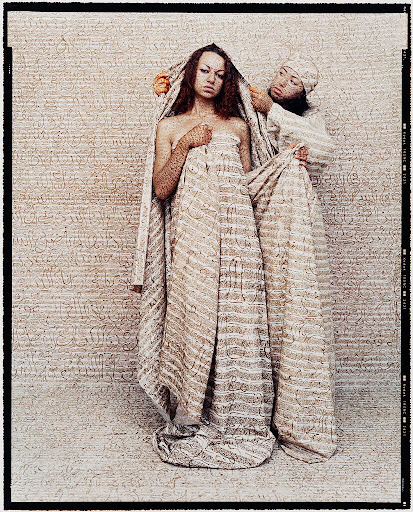
Since all the object entries with 0 page views were of Lalla Essaydi’s work contrasting against her piece Les Femmes Du Maroc #45 being the most viewed in the culture, I wanted to see whether there was a pattern relating to the page views correlating to the accession year by the museum. All 11 pieces with 0 views by Essaydi were either gifted by Donald and Alison Weiss or Jeffrey Hugh Newman in 2023. All the 11 pieces are new additions not only to the museum’s collection but to the website as well with no photographic documentation of the piece. It makes me wonder whether the lack of photography is because the pieces are yet to be exhibited physically in the museum creating an aura of mystique to the art before being displayed. Does an artwork need to be exhibited to qualify for a full breakdown of the piece on the site? In contrast Les Femmes Du Maroc #45 was acquired by the museum in 2009 explaining why it has a lot more views than the other pieces of the same collection. Having made that distinction on pageviews moving parallel to the accession year in Essaydi’s work, I wanted to see whether the other pieces in the Moroccan culture were affected by the same pattern.
Initially just looking at the spread of objects on Posit Cloud, I can see that all the pieces unrelated to Essaydi were either textiles or pottery fragments. The pieces did not follow the same pattern as Essaydi’s work however, since all of them were acquired before the 2000s even as early as 1916 it made sense as to why they had higher page views even when photographic documentation was not available. These pieces have existed in the Museum for a long time therefore connecting their ownership to the museum. I believe that as archaeologists search for pieces from the Moroccan culture, knowing how long some of them have been in the museum’s possession the Museum has possibly built a repertoire of owning the fragments and being a stable resource for researchers to check the pieces out.
This method of parsing through a culture was very eye opening to me. As a type A person myself, I enjoy classification more than anything, and being able to pinpoint all objects within a specific tag instead of individually finding them on the website was very helpful. It makes understanding acquisition patterns at museums a lot simpler to analyse.
PART III:
For the last part of this assignment, we were asked to compare three of the cultures in the Harvard Art Museum website. I looked back at the CSV file and randomly picked two cultures with the third being the Moroccan culture I used in part two of this assignment. The cultures I picked were Brazilian and Venezuelan which was very exciting to me. I always joke around with my friends and cousins that I was South American in a past life, so I knew this was going to be enjoyable.
I started the assignment by running the notebook on Posit Cloud to see how the number of objects compared between the cultures as well as their accession years. Brazilian culture had almost three times as many objects as both the other cultures, however, they were all close in range with none being a significant outlier. The accession years of the objects was insightful as well. The graphs show Moroccan objects to be the ones most acquired over time, however, what I found quite surprising was that since I had just done the second part of the assignment on Moroccan objects, the jump in gifted pieces in 2023 was nowhere to be found on the graph. So I did start to question the credibility of the graphs knowing that the results I got before weren’t reflected completely.
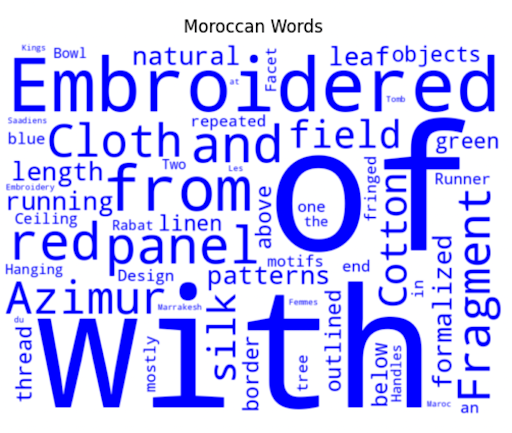
Moving on to the main goal of this section of the notebook, the word cloud comparison of the objects in the three cultures does tell us a lot more about the reasons behind their acquisition. Starting with the first culture, the Moroccan word cloud was very reflective of the Moroccan objects being mainly textiles and pottery fragments. In fact one of the most prominent words in the cloud was “fragment.” Other words included “cloth,” “embroidered,” and “runner,” all of which are very connected to rugs and textiles that we have seen in assignment two. I was just surprised to not see any words relating to the work by Lalla Essaydi’s photography.
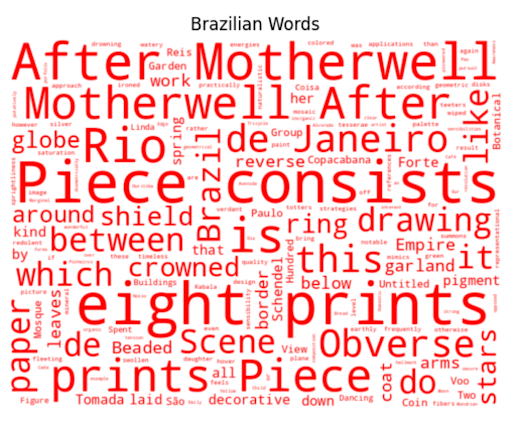
Moving on to the second culture, Brazilian objects seem to be often in connection to Rio de Janeiro since the word fills up the largest part of the cloud. I can assume from the word cloud that a lot of the acquired pieces are themed around landscapes. A lot of the words on the word cloud are “garden,” “garland,” “spring,” and “leaves.” Artworks probably are in the form of prints or beadwork as those two words also seem relevant on the cloud. Overall from the word cloud, the glimpse I get into Brazilian objects at the Harvard Art Museum are in relation to the landscape or the coat of arms in Brazil.
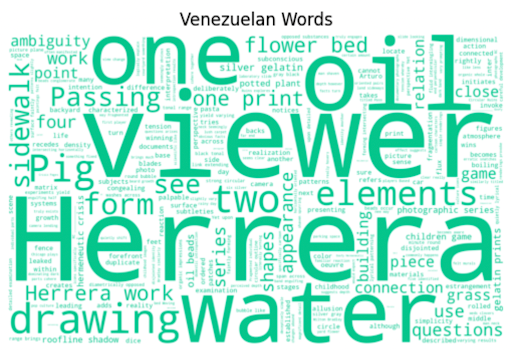
Finally, the Venezuelan culture which had the least number of objects to begin with and their total count being less than 10 objects, I would assume the notebook would better analyse the small acquisition. Again we see beads in the wordcloud and references to landscape, however in contrast to Brazil, the landscape of Venezuela is more so about the architecture than nature. There is also mention of oil which can be either crude oil or oil paint, and knowing anything about Venezuela, crude oil is a very prominent part of the country’s GDP. A name however, Herrera, comes up as the most prominent in the cloud. It could allude to the pieces being from the same artist named Herrera or about a figure named Herrera, as far as I know the only Venezuelan Herrera of importance to me is the football player.
In conclusion, the word cloud of all three cultures gives us insight into what is deemed worthy for acquisition in the West, maybe at a surface level. However, a deeper analysis into the specific pieces is required to properly analyse the objects and their relation to the Harvard Art Museum besides their language tags. This exercise introduces us to the language of computers and big data. It is a much simpler way to parse through large amounts of work at once. However, as helpful as this was, it does in my opinion require a lot of preemptive preparation by humans or other machines to classify the data into categories ready to be analysed.
